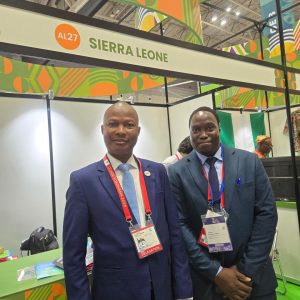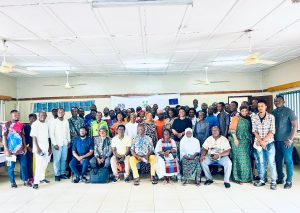HFAC-SL Leads Advocacy for Child Survival Funding

By Abdul Rahman Bah
The Health for All Coalition Sierra Leone (HFAC-SL), in partnership with the Ministry of Health and Sanitation’s National Child Health Program, hosted a high-level sensitisation meeting with media practitioners, social media bloggers, and civil society organisations on August 8, 2025, at the SLAJ Hall on Campbell Street, Freetown. The gathering aimed to build a united front in promoting sustainable funding and awareness around child health issues, a sector that continues to grapple with high under-five mortality and preventable illnesses.
Chief Muana Brima, Program Manager of the Coalition of Civil Society, opened the engagement with a heartfelt call for collective action. Representing the M4 World Commission, he welcomed attendees and emphasised the urgent need for cross-sector collaboration to protect Sierra Leone’s children. He highlighted that healthy children are not only a moral priority but also a catalyst for sustainable development. Without health, he said, there is no education, economic growth, or national progress. He stressed that one in ten children under five in Sierra Leone continues to die from preventable causes, a figure that represents a national crisis demanding immediate response.
Mr. Charles Mambu, Executive Director of HFAC-SL, elaborated on the transformation of the Child Health Program from being a subset of the immunisation program into a standalone national priority. He praised the leadership of Dr. Lynda Farma Grant, who now leads the program and has been instrumental in developing a strategic roadmap to improve child health services across the country. Mambu stated that the program’s key goal is to reduce child mortality and improve survival rates, and that this cannot be achieved without strong media partnerships, adequate funding, and collective accountability. He noted that investment in children is not mere expenditure, but a long-term deposit into the development bank of the nation.
He further urged participants—journalists, editors, bloggers, and activists—to use their platforms to advocate for increased government spending on child survival initiatives. Mambu underlined that the media plays a powerful role in shaping public opinion and policy, and its daily content can significantly influence both national consciousness and international donor attention. He expressed deep appreciation for the presence of key figures in Sierra Leone’s media landscape, including Guse Osano, Amara Samura, and others, and called for their sustained involvement in spreading the message of child health advocacy.
Dr. Lynda Farma Grant delivered a detailed presentation on the evolution, objectives, and strategic pillars of the National Child Health Program. She provided data showing how Sierra Leone has significantly reduced under-five mortality since the 1990s, but emphasised that the current rate of 94 per 1,000 live births is still far from the national target of 25 per 1,000 by 2030. With just five years remaining to meet the Sustainable Development Goal (SDG) targets, she stressed the urgency of refocusing national priorities on child survival. She highlighted the importance of creating an enabling environment where every child not only survives but thrives safe from violence, well-fed, educated, and able to reach their full potential.
She recounted how in 2022, during the World Health Assembly in Geneva, Sierra Leone’s Health Minister made a global appeal for support to address child mortality. This led to an international diagnostic mission and the development of a two-year Child Survival Action Plan. The plan outlines specific steps to reduce under-five deaths by tackling systemic weaknesses, expanding access to care, and improving accountability in health delivery. Dr. Grant explained that many child deaths are caused by easily preventable diseases such as malaria, pneumonia, and diarrhoea. In other cases, newborn complications due to poor maternal care and delayed access to hospitals were also to blame.
The plan also includes strategies for enhancing community awareness, reaching underserved rural areas, integrating private sector contributions, and ensuring the inclusion of children in national planning. She stressed that health should not be viewed solely as the responsibility of the Ministry of Health but as a shared national priority involving all ministries, civil society, donors, and citizens. The well-being of children, she said, is a collective responsibility that transcends political, economic, and religious boundaries.
Dr. Grant also pointed out the urgent need for data visibility and transparency. Many child deaths go unrecorded, particularly in remote communities, which hampers effective planning and response. She encouraged media professionals to help break the silence and stigma around child deaths and hold duty bearers accountable for service delivery. She called on all present to become “Child Champions” in their respective platforms not just reporting on child health when something goes wrong, but actively promoting stories of progress, advocacy, and innovation.
Participants welcomed the presentations with enthusiasm and committed to using their voices to amplify the importance of investing in Sierra Leone’s children. Mr. Amara Samura, Editor of Future Newspaper, thanked the organisers for the invitation and noted that media practitioners have an ethical obligation to advocate for vulnerable populations, especially children who have no voice of their own. He pledged to dedicate space in his publication to highlight child health issues and urged his colleagues to do the same.
The event concluded with a strong sense of unity and purpose. Participants agreed that this meeting would not be a one-off engagement, but the beginning of a national movement to prioritise child health as a cornerstone of development. HFAC-SL announced that further sessions would be held with donors, government institutions, and other stakeholders to ensure that the momentum gained would translate into measurable action. Attendees were also challenged to make personal and institutional commitments to feature child survival messages regularly in their respective platforms.
In a country still recovering from the aftershocks of war, poverty, and disease, the call to action was clear: Sierra Leone must no longer tolerate preventable child deaths. Through sustained advocacy, bold partnerships, and smarter investments, a future where every child lives, learns, and leads is not only possible but necessar





